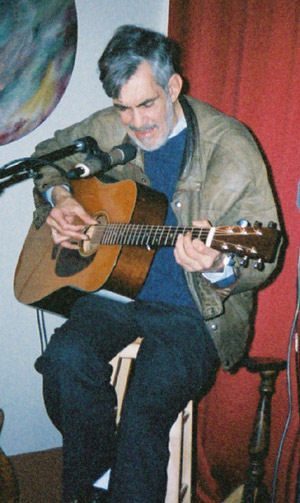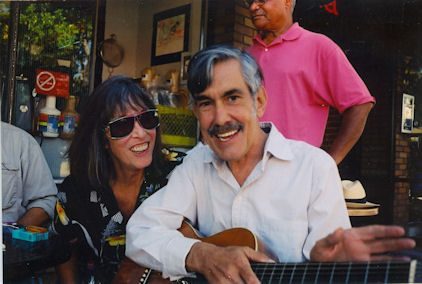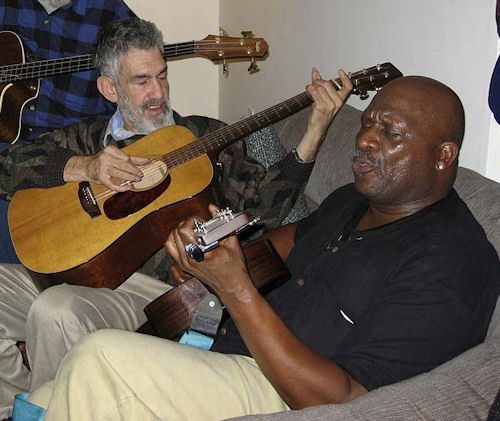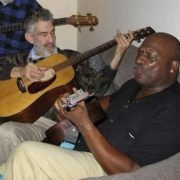Steve Mann RIP
Steve Mann
May 2, 1943 – September 9, 2009
 Steve Mann wanted to achieve some kind of immortality as a guitarist, and wasn’t afraid to admit it. To him that meant meeting the standards set by only one guitarist, the one who sold his soul to the devil at a famous meeting at the Crossroads, in exchange for which he would be able to play the blues like no one had ever played them. It was a Faustian bargain and Robert Johnson paid for it with his life.
Steve Mann wanted to achieve some kind of immortality as a guitarist, and wasn’t afraid to admit it. To him that meant meeting the standards set by only one guitarist, the one who sold his soul to the devil at a famous meeting at the Crossroads, in exchange for which he would be able to play the blues like no one had ever played them. It was a Faustian bargain and Robert Johnson paid for it with his life.
In the end, so did Steve Mann. But let me start at the beginning.
If LA had a Mt. Rushmore of folk guitarists I know who would be on it: Ry Cooder, who at 16 could play Blind Blake so you couldn’t tell the difference between them; David Cohen, a hulking Buddha statue of a man who taught an entire generation of guitar-enthusiasts to finger-pick like their favorites, from Doc Watson to Elizabeth Cotton; Dick Rosmini, who played the 12-string guitar in the movie Midnight Special, based on Leadbelly’s life, even though the filmmaker had to conceal his white hands; and Steve Mann, the most exciting ragtime and blues style guitarist I ever saw, who stole the show at the Ash Grove no matter who else was on stage.
They were the Pantheon when I was growing up here, content to boom-chicka-boom my way through the Woody Guthrie, Johnny Cash and Carter Family Songbooks, but only too happy to be dazzled by those for whom guitar was not merely a means to an end-the accompaniment of a song-but an end in itself, their primary vehicle for musical expression.
But Shakespeare was right-genius is to madness near allied-and Steve Mann was living proof.
At the height of his success as LA’s most sought after finger-style guitarist-who played 12-string on Sonny and Cher’s greatest hit, I Got You Babe-Steve Mann succumbed to the torture of mental illness, and spent the next decade or two medicated at a string of halfway houses and psychiatric rehab facilities. His public persona all but obliterated by his private demons, I was lucky enough to meet and befriend him at one such residential treatment center-the Golden Gate Lodge, where I performed on a regular basis throughout the 1990s.
After one of my performances, this shy resident quite abashedly approached me and started to compliment me on my guitar playing and singing. Then he mentioned that he too played guitar.
He was certainly not the first such patient to approach me after a show-for I was doing over 300 a year at nursing homes and psych facilities-and tell me that he played guitar. I always asked them more, and often engaged them in conversation, as best as I could. So I asked him his name, and when he said “Steve Mann,” my jaw dropped. I knew who he was, and I knew what he looked like.
I didn’t even have to ask if he was “the” Steve Mann-I could tell immediately, as soon as he mentioned his name. “I know who you are,” I told him, and that I was very moved at his compliment of my guitar playing. I had heard him play at the Ash Grove many times back in the 1960’s, and was enthralled by his ragtime and blues mastery.
The Ash Grove-Ed Pearl’s legendary 1960s folk club-was LA’s home-away-from-home to the best folk musicians in the country, and played no favorites when it came to putting on local performers. If you wanted to play there you weren’t just competing with the guitarist down the street or across town. You were competing with Mississippi John Hurt or Mance Lipscomb or Dave Van Ronk.
Steve Mann was born and raised in the San Fernando Valley. Both he and I learned to play guitar in a UCLA Extension class taught by Bess Lomax Hawes where he eventually attracted the attention of Dick Rosmini, whereas I attracted the attention of my relatives. Steve became Rosmini’s student and, proving how good a teacher Dick was, became as good as the best in the country; that’s why he played the Ash Grove. And yet, by the time I met him he couldn’t even play the Golden Gate Lodge. That’s what mental illness can do to you. Not every schizophrenic has a beautiful mind, and Steve at that time was barely keeping his head above water. He wouldn’t play guitar for me, even though I asked him again and again. He just wasn’t able to crawl out of his dark dungeon.
Eventually I moved on, and so did Steve. I lost track of him until one day, while reading some CD reviews in FolkWorks-I did a double take. Steve Mann had released some new work-and was starting to perform again-up in Berkeley, where harmonica player and friend Will Scarlett had enabled him to move. He also gave Steve a guitar-a beautiful Gibson-Epiphone, with the signature e on the pick-guard.
There are no second acts in American lives? Steve proved F. Scott-Fitzgerald wrong.
The first of his CDs issued by Janet Smith of Berkeley’s Bella Roma Music was called Alive and Picking, to put an end to the long-circulating rumors that he was dead, which like those about Mark Twain, turned out to be greatly exaggerated. The second CD, made from a collection of old tapes sent to her by Steve’s friends, is called Live at the Ash Grove-a collection of performances from his artistic triumphs at LA’s premiere venue for worshippers of folk guitar. I could not have been more delighted.
Having lost more than a decade to mental illness, Steve went back to performing what he slyly called “Mannmade Music.” This was 2003. Then just recently I heard from my childhood friend Jim Alexander who lives in Berkeley and he mentioned that Steve Mann had died tragically from a traumatic head injury caused by a fall at a nursing home in Richmond, California. According to Janet Smith, he was recovering from a delicate but successful surgery to remove an aneurysm from just below his brain. He was then moved to a new nursing home, where despite good care his head wound became infected and what had at first seemed like one more setback in a life full of them proved to be fatal.
A recent web site posting by Ms. Smith, head of his record company Bella Roma Music, adds some essential details:
Dear Friends and Mann Fanns:
This is a sad notification that Steven David Mann passed away on Sept. 9, 2009 at a nursing home in San Pablo, California. He had suffered serious brain damage from a series of falls after a surgery in 2008, and declined steadily over the next year. He was beloved and admired both as a gentle soul and as a world- class musician.
So it is time to assess this mad genius-who set the standard for a myriad of guitarists who poured over his arrangements for clues to his stunning virtuosity like Egyptologists scrutinizing the Rosetta Stone. For starters, he wasn’t just a stage performer, by whom occasional mistakes are tolerated by ears that are trained to move on and listen for the over-all impression of a performance rather than one imperfect note.
Steve’s standards were based on studio recordings, where mistakes are unacceptable, and where in the pre-digital age you either had to splice tape or do another take. It didn’t matter to Steve. In his prime he didn’t make mistakes; studio time was too valuable. In his best-known session he thus played the distinctive twelve-string accompaniment to Sonny and Cher’s biggest hit-I Got You Babe-as well as their earlier hit, Bob Dylan’s All I Really Want to Do.
But it was his guitar accompaniment to a then unknown girl singer from Texas of which he was most proud. Her name was Janis Joplin-you may not have heard of her in 1963 when these recordings were made–but you wouldn’t mistake her instantly recognizable voice on Steve Mann’s recording, with a sad irony called Alive and Picking. She’s featured on three tracks long before her explosive rock growl turned the 1967 Monterey Pop Festival into her coronation. Four years earlier, just arrived from Texas with traces of a sweet twang still firmly in place, her ambition was to make it as a folk singer. She occasionally teamed up with the best folk guitarist she could find-and that was Steve Mann, who backed up Janis Joplin when she was still aiming to be a Lone Star State troubadour.
 In 1967 Janis moved onto greater heights of acclaim than she could have imagined, and Steve Mann, like a gritty 1960s blues version of A Star Is Born, started a long slow descent into madness and halfway houses. The dark days of the late 1960s proved to be a black hole for Steve Mann, who took roughly twenty years to climb out and start over. Perhaps that is what defines the blues; if so, Steve certainly lived the life he sang about. (Although According to his sister Devorah, Steve used to say he wished he’d been born poor, black, and in the south, since that would have made him a better blues singer).
In 1967 Janis moved onto greater heights of acclaim than she could have imagined, and Steve Mann, like a gritty 1960s blues version of A Star Is Born, started a long slow descent into madness and halfway houses. The dark days of the late 1960s proved to be a black hole for Steve Mann, who took roughly twenty years to climb out and start over. Perhaps that is what defines the blues; if so, Steve certainly lived the life he sang about. (Although According to his sister Devorah, Steve used to say he wished he’d been born poor, black, and in the south, since that would have made him a better blues singer).
But start over he did, and we have his recent CDs and a few live performances to prove it, and to be very grateful for indeed. Stefan Wirz created an unofficial but meticulously well-documented web page devoted to his music, with many samples from numerous tracks to whet your appetite for more. And more recently Janet Smith, head of his new record company, Bella Roma Music, finally succeeded in copyrighting his music, and started his own official web site with a number of wonderful stories behind some of his best-known songs and guitar instrumentals, such as Holly, transcribed from Steve’s playing on the CD Steve Mann; Alive and Pickin’. On the web site you will find out how his then girlfriend Holly totaled his car, dumped him in San Francisco for another guy, took all the proceeds from a job that was supposed to pay both of them, and how Steve ultimately got even with one of the most beautiful guitar solos ever written. And you thought the 60’s were over.
Speaking of the sixties, Steve Mann was always welcome to hang his hat at Margot St. James’ place in San Francisco during the height of the Haight-Ashbury era. Margo proved to be a loyal friend to the end, introducing him to Mose Allison in person, whose music Steve had long admired.
Among the many photos on his web site of Steve playing guitar, playing chess, hanging out at the French hotel, you will find something else there too-a shy, sly, slightly-off center smile that conveys a small sense of triumph, that found a way out of Dante’s dark wood in middle age. And if he didn’t quite manage to outlive his demons, he did reach a respectable age of 66 before he finally left a world that gave him so much pain, and out of which he transformed that pain into the lasting joy of great art.
If that is immortality, Steven David Mann earned it. He is survived by his sister Devorah, his brother Jim, and a hundred armchair guitarists who go to sleep at night dreaming that they will wake up and be able to play like him. But there was only one Steve Mann.
Steve Mann’s web site is www.stevemanngtr.com His newly reissued album is called Straight Life. Janet Smith held a memorial for him last September 20 at Bella Roma Music. Also recommended is Stefan Wirz’s unofficial web page devoted to Steve Mann at www.wirz.de/music/mann_st.htm
Ross Altman has a Ph.D. in English. Before becoming a full-time folk singer he taught college English and Speech. He now sings around California for libraries, unions, schools, political groups and folk festivals. You can reach Ross at Greygoosemusic@aol.com













